Reducing waste and taking action on climate change
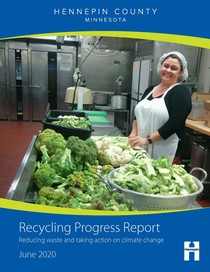
Hennepin County’s annual Recycling Progress Report (PDF) provides an update on our efforts to meet our goals of recycling 75% of waste and sending no waste to landfills by 2030.
In 2019, county residents and businesses discarded about 1.45 million tons of solid waste. This includes everything put into recycling, organics recycling, and trash. That is about a 3% increase over 2018, or about 40,000 tons more.
The county’s recycling rate, which includes conventional recycling and organics recycling, was 49%, about the same as in 2018. The remaining waste was managed as trash, with 22% going to waste-to-energy facilities and 29% to landfills. A greater proportion of garbage was sent to landfills in 2019 due to the closure of the Great River Energy Elk River Resource Recovery Project at the beginning of the year.
The report reflects on 50 years of waste management in Hennepin County – from open dumps and burn barrels in the 1970s to the development of recycling, organics recycling, hazardous waste management, and waste prevention programs throughout the 1980s, 1990s, and 2000s.
Looking ahead to the future of environmental protection in Hennepin County, core services developed over the past 50 years to reduce and responsibly manage waste will continue. We are also focusing on making progress on our current priorities, which include taking action on climate change, expanding organics recycling, reducing food waste, and striving for zero waste.
Read a summary of the 2019 successes and download the report.
For more information, contact Ben Knudson at ben.knudson@hennepin.us or 612-596-1176.
|

Hennepin County’s first online Zero Waste Challenge wrapped up in June. During the challenge, 427 participants took more than 2,300 actions. Participants reported composting over 1,000 pounds of waste, avoiding 1,400 pounds of waste through waste reduction actions, and avoiding over 600 plastic items.
The top 10 most common actions that participants committed to were:
|
- Decluttering
- Stopping wish-cycling
- Reducing junk mail
- Completing a waste audit
- Recycling paper, cardboard, plastic, metal, and glass
- Planting a garden
- Recycling plastic bags
- Finding local recycling drop-off centers
- Making green cleaners
- Recycling more organics
Reducing food waste challenge coming in September
The next online challenge will focus specifically on reducing food waste.
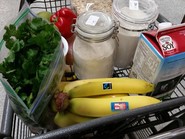
Food waste is a big problem in the U.S. – about 40% of food is wasted somewhere along the supply chain. Food waste costs a lot. The average family of four spends $1,800 on food they’ll never eat and just end up throwing away. Wasted food also wastes a ton of resources, including all of the water and energy that goes into growing and transporting it. Wasted food has such a big impact that reducing the amount of food we waste is one of the most important things we can do to address climate change.
Surprisingly, consumers are the biggest contributor to the food waste problem. But that’s also good news. We have the power to significantly reduce the amount of food that goes to waste and save ourselves money by making changes at the grocery store and right at home in our kitchens.
The next online challenge will provide helpful resources and effective strategies to reduce food waste. Registration will open at the end of August.
|

To help divert waste from landfills, Hennepin County has grants available for homeowners and developers to deconstruct buildings to salvage building materials rather than demolish them. Compared to standard demolition techniques that use mechanical equipment to knock down structures, deconstruction involves carefully dismantling buildings to salvage building materials for reuse. About 85 percent of the materials in a typical demolition or remodeling project could be salvaged and kept out of landfills. But currently, only about 30 percent of building materials are reused or recycled.
Homeowners and developers of residential properties can receive up to $5,000 to help offset the additional time and labor costs associated with deconstruction. Projects must be located in the following cities: Brooklyn Center, Brooklyn Park, Deephaven, Edina, Excelsior, Greenfield, Greenwood, Hopkins, Minneapolis, Maple Grove, Mound, St. Louis Park, and Woodland. Additional cities are being added on an ongoing basis.
Learn more about the grants, including eligibility and requirements, and apply online.
|

The Minnesota Department of Agriculture (MDA) has been receiving reports of residents receiving unsolicited packages of seeds appearing to come from China.
Minnesotans should do the following if they have received unsolicited packages of seeds.
- Do not throw away the package or its contents.
- Do not plant the seeds.
- Contact Arrest the Pest line at 1-888-545-6684 or arrest.the.pest@state.mn.us and provide your name, contact information, and the date the package was received.
We encourage people to plant native plant and seeds from reputable seed sources.
Read more in this Star Tribune article: Don't plant these: Packages of mystery seeds arriving in Minnesota mailboxes
|
Our Green Partners environmental education newsletter has been showcasing some great environmental education resources that are available to families to explore nature and learn about environmental issues right from home. Here are some of the resources to check out. Sign up for Green Partners to get monthly environmental education updates.
Explore the Mississippi River with Big River Journey Online
Big River Journey Online is the next best thing to a riverboat field trip on the Mississippi River! Filled with fun and exciting video clips and interactive learning modules about birds, boats, bugs, water quality and much more, the new Big River Journey Online allows kids to explore the mysteries of the Mississippi from school or home. Kids can peak into an eagle’s nest, spy on a romp of otters, spend time in a riverboat pilot house, imagine a waterfall greater than Niagara on the Mississippi, and solve river crimes.

Project Learning Tree family activities and videos
Project Learning Tree has free activities for families that help connect children to the outdoors. A variety of activities are available for different settings, including walking in a forest, visiting a local park, exploring your backyard, and while spending time inside. The Project Learning Tree community has also been creating video demonstrations of some favorite activities that students or participants can easily do at home.

Project WET online resources
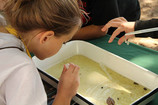
Project WET (Water Education Today) is offering a suite of free and discounted resources that educators, parents, and children can use to learn about water while meeting standards in math, language arts, science and fine arts.
|
Online lessons from Wolf Ridge Environmental Learning Center
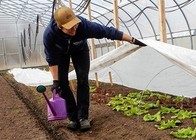
Wolf Ridge has released a series of online, standards-based lessons for schools, organizations, and families. In each lesson, students explore Wolf Ridge and their own backyards, experiencing nature from a variety of perspectives including science, history, culture, art, and literature. Every lesson includes an interactive StoryMap or teacher-guided written story and activity handouts, a 5 to 10 minute video adventure with Wolf Ridge Naturalists, and two activities for students and families. Lessons have been developed on birds, geology, food and farming, soundscapes, mysterious animal signs, and more.
|
Jeffers Foundation instructional videos
The Jeffers Foundation, a local environmental education organization, is offering a series of videos called Jeffers@Home. Each video offers instructions on a different topic for having fun with Mother Nature right at home. Videos include animal signs, listening walk, recycling in natural, preschool nature journal, and wind energy.

Backyard composting webinar
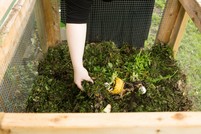
Composting is a great way to reduce your waste and add nutrients back to your soil. Learn how to make compost in your backyard! This webinar will cover how to set up and maintain a compost pile.
There are two opportunities to participate:
- Wednesday, August 19 from noon to 1 p.m.
- Thursday, September 10 from 5 to 6 p.m.
The is no charge to sign up, but space is limited and registration is required. Register here.
|
With an increase in online shopping while people are spending more time at home, staff at Hennepin County drop-off facilities and recycling centers throughout the Twin Cities have seen an increase in packaging waste. Many of the materials that come with online orders can be recycled, but there are some steps you need to take to make sure they get recycled properly.
Follow the tips below, and see the Green Disposal Guide for recycling and disposal information for common household items.

Cardboard
Cardboard boxes can be recycled in your recycling at home. Empty and flatten boxes before putting them in the recycling. If you have a lot of boxes, check with your hauler to see if they can be placed alongside your recycling cart. Cardboard is also accepted at Hennepin County drop-off facilities.
Plastic film, air pillows, bubble wrap
Plastic film, air pillows, and bubble wrap can be recycled in drop-off bins for plastic bags and film. They are not accepted in your recycling at home. Plastic bags and film must be clean and dry, and plastic air pillows should be deflated. Find locations and check what can be recycled at plasticfilmrecycling.org. Some locations are not currently accepting plastic bags and film for recycling, so be sure to check before bringing in your items. Plastic bags and film are also accepted at Hennepin County drop-off facilities.
Paper used for packing
Paper used for packing can be put in your recycling at home. Ideally, the paper would be folded or flattened instead of balled up. This will help ensure it is properly sorted at recycling sorting facilities.
StyrofoamTM
StyrofoamTM is not recyclable. Reuse StyrofoamTM for future packaging and mailing needs or put it in the trash.
Shipping envelopes
Shipping envelopes that are made entirely of plastic can be recycled at locations listed on plasticfilmrecycling.org. They are not accepted at Hennepin County drop-off facilities. Envelopes made of a mix of materials, like paper and bubble wrap, should go in the trash.
|